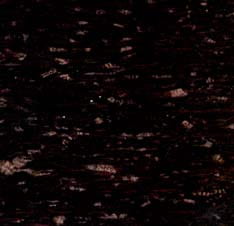 The Berlin and Utley rhyolite are considered the same rock although they are separated by almost 10 miles. The most extensive work in the area, starting in 1886, was done by the E.J. Nelson Granite Co. The E.J. Granite co controlled thirty acres arou nd their mine, in this area they dug two major openings. Both of the openings were over 150 feet long 60 feet wide and 50 feet deep. The rock that they were pulling out of the holes were never over 18ft. by 4ft. in size. The rhyolite from this quarry is a compact, dense rock. The color is a grey black but gets a light pink tint by the feldspars that formed with the rock. There is one good side to polish the others don’t shine with the same luster as the face (run, head surfaces). The rock turned out to be a great stone for monumental purposes. In fact there are still head stones made of Berlin Rhyolite that were polished over a century ago that still maintain the same high gloss they did when they were new. Berlin Rhyolite is also used extensively for bui lding purposes The science hall at UW Madison was created in part from this stone, as was the Bartlett Building in Chicago. The stone was also used for paving blocks in the Milwaukee and Chicago area. Hundred of thousands of the paving blocks are laid on these streets. Cross walks and curbing have also been cut and sold in large quantities to the surrounding cities
The Berlin and Utley rhyolite are considered the same rock although they are separated by almost 10 miles. The most extensive work in the area, starting in 1886, was done by the E.J. Nelson Granite Co. The E.J. Granite co controlled thirty acres arou nd their mine, in this area they dug two major openings. Both of the openings were over 150 feet long 60 feet wide and 50 feet deep. The rock that they were pulling out of the holes were never over 18ft. by 4ft. in size. The rhyolite from this quarry is a compact, dense rock. The color is a grey black but gets a light pink tint by the feldspars that formed with the rock. There is one good side to polish the others don’t shine with the same luster as the face (run, head surfaces). The rock turned out to be a great stone for monumental purposes. In fact there are still head stones made of Berlin Rhyolite that were polished over a century ago that still maintain the same high gloss they did when they were new. Berlin Rhyolite is also used extensively for bui lding purposes The science hall at UW Madison was created in part from this stone, as was the Bartlett Building in Chicago. The stone was also used for paving blocks in the Milwaukee and Chicago area. Hundred of thousands of the paving blocks are laid on these streets. Cross walks and curbing have also been cut and sold in large quantities to the surrounding cities